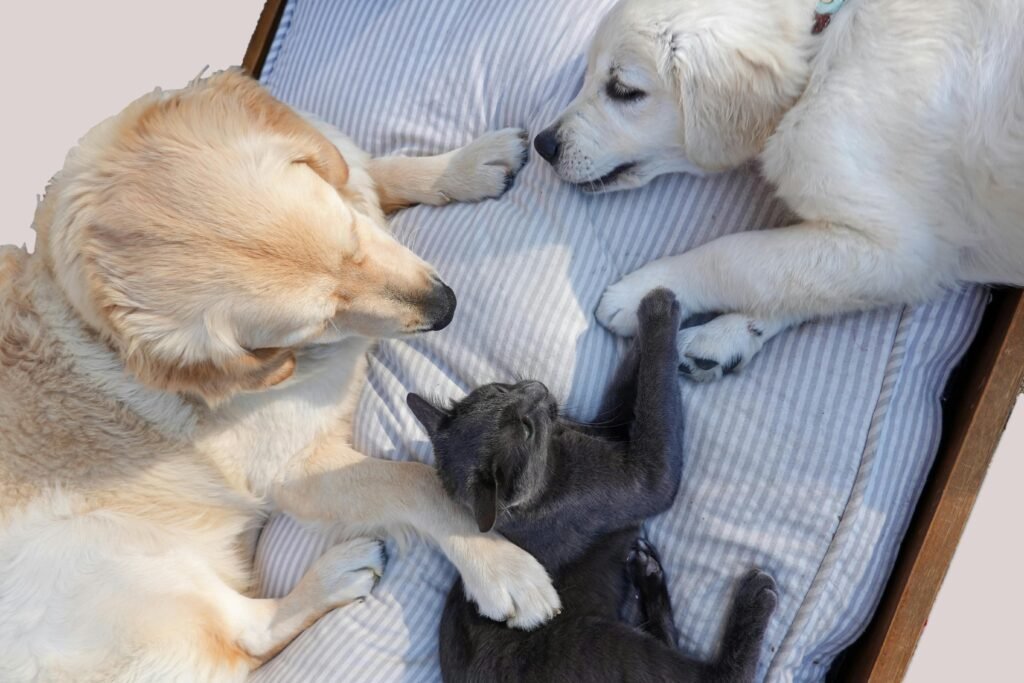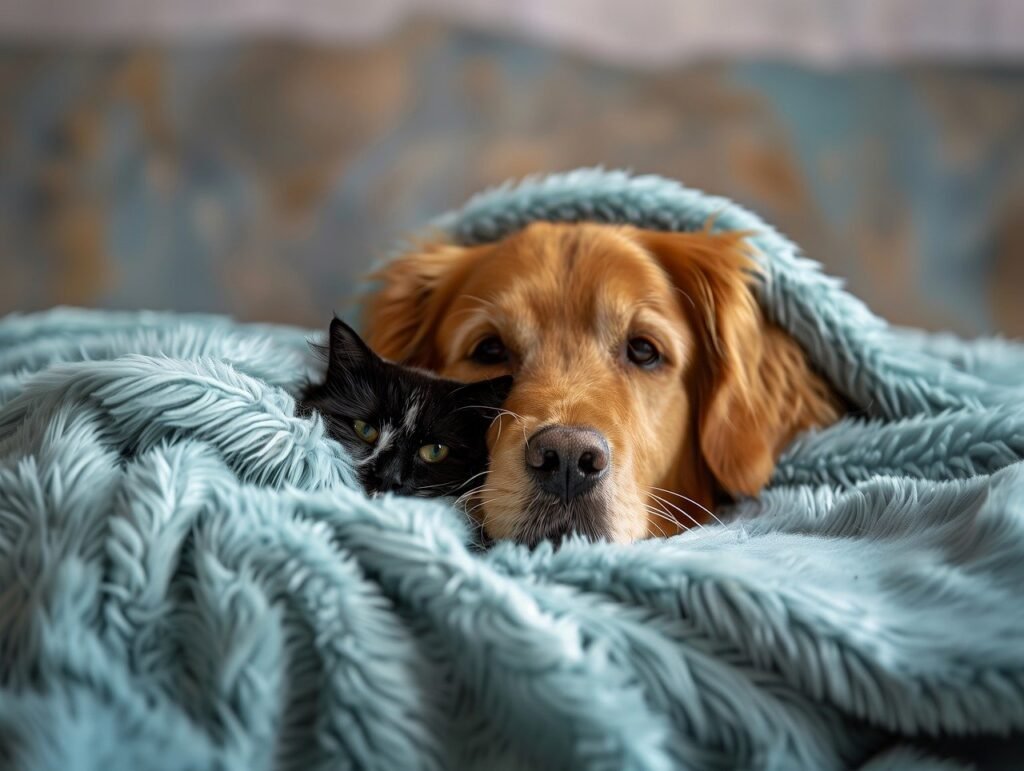Are Golden Retrievers Good With Cats?15 Essential Things and Tips For Pet Owners
Golden Retrievers and cats are two beloved pets that many households desire to have.
However, when considering adding a Golden Retriever to a home that already has a cat, there are several important factors to consider.
In this comprehensive guide, we will delve into whether Golden Retrievers are good with cats, providing 15 essential tips for harmonious cohabitation.
Yes, Golden retrievers are good with cats. Here are some reasons why:
7 Reasons Why Golden Retrievers Make Great Companions for Cats
Golden Retrievers stand out as one of the most affable and good-natured breeds in the canine world.
Their innate friendliness and docile temperament render them not just ideal companions for humans but also apt partners for various household members, including our feline friends.
If you’re pondering whether a cat can live harmoniously with a Golden Retriever, the answer often leans towards a resounding yes.
Let’s delve into the reasons why:
1. Gentle Nature
Golden Retrievers are renowned for their calm and amiable demeanor. This inherent gentleness extends to their interactions with other animals, including cats. Their non-threatening presence and relaxed disposition make them less likely to exhibit aggression towards their feline counterparts.
2. High Trainability
Intelligence coupled with a willingness to learn are hallmarks of Golden Retrievers.
This combination makes them highly trainable, even when it comes to interacting with cats.
With proper guidance and consistent training, Golden Retrievers can quickly grasp the importance of respecting the boundaries and space of their feline companions.
3. Social Personalities
As descendants of pack animals, Golden Retrievers possess a strong social inclination. While cats are often portrayed as independent creatures, they, too, can appreciate the company of others, especially when it comes from a friendly and sociable dog like the Golden Retriever.
Over time, this social bond can lead to mutual acceptance and companionship between the two species.
4. Playful Companions
Golden Retrievers are renowned for their playful and curious nature.
This playful disposition extends to their interactions with cats, where they can engage in mild play sessions.
Through play, Golden Retrievers and cats can bond and develop a mutual understanding, reducing the likelihood of any potential conflicts or animosity.
5. Size and Temperament
Despite their large size, Golden Retrievers are not overly dominant or intimidating.
Their balanced temperament and gentle demeanor mean they are less inclined to chase or intimidate cats, especially when trained properly.
This compatibility in size and temperament fosters a sense of security and comfort for both pets.
6. Early Socialization Benefits
Introducing Golden Retrievers to cats at a young age can yield significant benefits. Golden Retrievers exposed to cats during their formative months are more likely to view them as members of their pack rather than as potential prey. This early socialization lays the foundation for a harmonious relationship between the two pets.
7. Mutual Curiosity
Both cats and Golden Retrievers share a natural curiosity about their surroundings.
This mutual interest can catalyze building a friendly relationship between them.
Over time, their shared curiosity fosters mutual respect and understanding, with each animal appreciating the other’s space and boundaries.
However, it’s crucial to acknowledge that individual personalities and past experiences play a pivotal role in determining the success of their cohabitation.
While Golden Retrievers and cats have the potential to coexist harmoniously, it’s essential to emphasize early socialization, positive reinforcement, and supervised interactions to ensure a peaceful and fulfilling relationship between them.
A Guide to Introducing Your Golden Retriever and Cat
Introducing a Golden Retriever to a cat is a delicate process that requires patience, understanding, and a systematic approach.
Here’s a step-by-step guide to ensure a smooth and stress-free introduction:
Prepare Separate Spaces
Before the introduction, it’s crucial to establish separate areas for your Golden Retriever and cat within your home.
This allows each pet to have their territory where they can feel safe and secure. Set up comfortable bedding, food, water, and litter boxes in each designated area.
Scent Familiarization
Before your pets meet face-to-face, it’s essential to familiarize them with each other’s scent.
Swap bedding or toys between the two areas so they can get accustomed to each other’s smell. This helps reduce the element of surprise and can ease their initial anxiety.
First Introduction
For the initial meeting, keep your Golden Retriever on a leash and allow your cat to come and go as it pleases.

Choose a neutral location for this encounter, such as a spacious living room, where neither pet feels territorial. Keep the atmosphere calm and relaxed to minimize stress.
Observe Body Language
Pay close attention to the body language of both pets during the introduction. Look for signs of stress, fear, or aggression, such as flattened ears, raised fur, hissing, or growling.
If either pet displays signs of discomfort, it’s essential to separate them and try again later.
Short and Supervised Interactions
During the initial meetings, keep interactions between your Golden Retriever and cat short and always supervised.
Start with brief sessions and gradually increase the duration as they become more comfortable with each other. Use treats and praise to reinforce positive behavior.
Positive Reinforcement
Praise both pets when they behave well during their interactions. Offering treats can also encourage positive behavior and create a positive association with each other’s presence. This reinforces the idea that good things happen when they’re together.
Safe Retreats
Ensure that both your cat and Golden Retriever have access to safe retreats where they can escape if they feel threatened or overwhelmed.
Provide hiding spots or elevated perches where they can relax and observe without feeling exposed.
Monitor Play
While Golden Retrievers are generally gentle, their size and playfulness can be intimidating to a cat.
Monitor their play sessions closely and intervene if things get too rough. Redirect their energy towards appropriate toys or activities to prevent any potential conflicts.
Progress Gradually
Don’t rush the introduction process. It may take days, weeks, or even months for both pets to become comfortable with each other.
The key is consistency, patience, and allowing them to develop their relationship at their own pace.
Seek Professional Help if Needed
If despite your efforts, the pets are not getting along or if there are persistent issues, don’t hesitate to seek advice from a professional animal behaviorist or trainer.
They can provide personalized guidance and strategies to help facilitate a harmonious relationship between your Golden Retriever and cat.
Top 3 Tips for a Successful Introduction Between Your Golden Retriever and Cat
Introducing your Golden Retriever to your cat is a significant step that requires careful planning and consideration.
To ensure a smooth and positive introduction, here are three essential tips to keep in mind:
Introduce Their Scents to Each Other
Before their face-to-face meeting, facilitate an introduction of your pets’ scents to each other.
Swap bedding or toys between the two to allow them to become acquainted with each other’s smell.
This process fosters familiarity and comfort, reducing the likelihood of tension or surprise during their initial encounter.
Facilitate a Neutral Territory Introduction
When initiating their first meeting, opt for a neutral territory where neither your Golden Retriever nor your cat feels territorial.
Select a spacious area such as a living room or backyard, devoid of any favored spots that might trigger defensive behavior.

Keep your Golden Retriever on a leash to maintain control while allowing your cat the freedom to approach or retreat as needed.
This approach ensures both pets feel secure and prevents any feelings of being cornered or threatened.
Ensure Close Observation and Supervision
During the initial interactions between your Golden Retriever and cat, it’s imperative to closely monitor them.
Keep a watchful eye for signs of stress, fear, or aggression from either pet, such as flattened ears, raised fur, hissing, or growling.
If any tension arises, calmly separate the pets and attempt the introduction again later. Gradually extend the duration of their interactions as they demonstrate signs of acceptance and comfort around one another.
By diligently supervising their encounters, you can intervene if necessary and prevent potential conflicts from escalating.
10 Indicators Your Golden Retriever And Cat Aren’t Gelling
While many Golden Retrievers and cats enjoy a peaceful coexistence, sometimes their personalities or past experiences can lead to friction.
It’s essential to recognize these signs early to address any issues and ensure the comfort and safety of both pets.
Here are ten signs that may suggest your Golden Retriever and cat aren’t getting along as well as they could:
Signs of Aggression: Growling, hissing, showing teeth, swiping, or biting from either pet could indicate potential conflict.
Continuous Following: If your Golden Retriever consistently follows the cat in a predatory manner, it might signal underlying tension.
Signs of Fear: Trembling, crouching, tail-tucking, or seeking refuge in high places by the cat suggests fear or anxiety around the dog.
Avoidant Behavior: If either pet actively avoids the other, hiding or steering clear, it may indicate discomfort in their presence.
Signs of Territorial Behavior: Marking territory or guarding resources like food bowls could suggest competition or unease between the pets.
Overly Rough Interaction: If play sessions frequently escalate to distress for one pet, it could be a sign of mismatched energy levels or discomfort.
Altered Eating Patterns: Refusing to eat, especially when the other pet is nearby, may indicate stress or fear.
Accidental Soiling: Accidents in the house, especially near the other pet’s belongings, could be a sign of territorial behavior or anxiety.
Vocalization Concerns: Whining from the dog or yowling from the cat when close could indicate discomfort or distress.
Over-Grooming: Over-grooming, particularly focusing on one spot in cats, maybe a response to stress or anxiety.
FAQs: Golden Retrievers and Cats
Are Golden Retrievers good with cats?
Golden Retrievers are generally known for their friendly and adaptable nature, making them compatible with various other pets, including cats.
What should I consider before introducing a Golden Retriever to my cat?
Before introducing a Golden Retriever to your cat, consider the temperament and socialization level of both pets, as well as their past experiences with other animals.
How can I ensure a smooth introduction between my Golden Retriever and cat?
To ensure a smooth introduction, prepare separate spaces for each pet, familiarize them with each other’s scent, and supervise their initial interactions in a neutral environment.
What should I do if my Golden Retriever and cat don’t get along?
If your Golden Retriever and cat don’t get along, consider seeking advice from a professional animal behaviorist to address any issues and ensure the well-being of both pets.
Can Golden Retrievers and cats develop a bond over time?
Yes, with proper introduction and positive reinforcement, Golden Retrievers and cats can develop a bond over time, leading to a harmonious relationship in the household.
Are Golden Retrievers suitable for households with cats?
Golden Retrievers can be suitable for households with cats, especially if they are well-trained, socialized, and introduced to cats at a young age.
Conclusion
In conclusion, while introducing a Golden Retriever to a home with a cat may require patience and effort, the potential for a loving and harmonious relationship between these two pets is significant.
By following these 15 essential insights and tips, you can foster a bond between your Golden Retriever and cat that enriches both of their lives.
Remember, with love, patience, and understanding, these furry friends can become inseparable companions.





